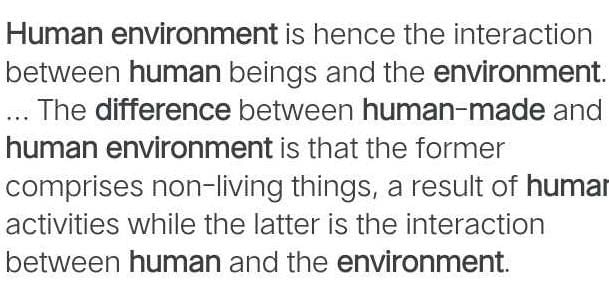Class 7 Exam > Class 7 Questions > Human and human made environment distinguish?
Start Learning for Free
Human and human made environment distinguish?
Most Upvoted Answer
Human and human made environment distinguish?

Community Answer
Human and human made environment distinguish?
Human and Human-made Environment
Humans and human-made environments can be distinguished based on their origin, characteristics, and impact on the ecosystem. Let's explore the differences between the two:
Human Environment
- The human environment refers to the natural surroundings in which humans live, including the air, water, soil, and biodiversity.
- It is created by nature and includes ecosystems such as forests, rivers, mountains, and deserts.
- The human environment provides essential resources for human survival and supports diverse forms of life.
- Humans interact with the natural environment through activities such as agriculture, fishing, and forestry.
Human-made Environment
- The human-made environment consists of structures, artifacts, and systems created by humans, such as buildings, roads, bridges, and technology.
- It is a result of human ingenuity and serves various purposes, including shelter, transportation, communication, and recreation.
- The human-made environment can have both positive and negative impacts on the natural environment and human well-being.
- Humans modify the human-made environment through urbanization, industrialization, and infrastructure development.
Distinguishing Factors
- Origin: The human environment is created by nature, while the human-made environment is constructed by humans.
- Characteristics: The human environment is characterized by natural elements, while the human-made environment is characterized by artificial structures and technologies.
- Impact: The human environment sustains life and ecosystems, while the human-made environment can have both beneficial and detrimental effects on the environment and society.
By understanding the distinctions between the human and human-made environments, we can appreciate the interconnectedness of human activities with the natural world and strive for sustainable development practices.
Humans and human-made environments can be distinguished based on their origin, characteristics, and impact on the ecosystem. Let's explore the differences between the two:
Human Environment
- The human environment refers to the natural surroundings in which humans live, including the air, water, soil, and biodiversity.
- It is created by nature and includes ecosystems such as forests, rivers, mountains, and deserts.
- The human environment provides essential resources for human survival and supports diverse forms of life.
- Humans interact with the natural environment through activities such as agriculture, fishing, and forestry.
Human-made Environment
- The human-made environment consists of structures, artifacts, and systems created by humans, such as buildings, roads, bridges, and technology.
- It is a result of human ingenuity and serves various purposes, including shelter, transportation, communication, and recreation.
- The human-made environment can have both positive and negative impacts on the natural environment and human well-being.
- Humans modify the human-made environment through urbanization, industrialization, and infrastructure development.
Distinguishing Factors
- Origin: The human environment is created by nature, while the human-made environment is constructed by humans.
- Characteristics: The human environment is characterized by natural elements, while the human-made environment is characterized by artificial structures and technologies.
- Impact: The human environment sustains life and ecosystems, while the human-made environment can have both beneficial and detrimental effects on the environment and society.
By understanding the distinctions between the human and human-made environments, we can appreciate the interconnectedness of human activities with the natural world and strive for sustainable development practices.

|
Explore Courses for Class 7 exam
|

|
Similar Class 7 Doubts
Human and human made environment distinguish?
Question Description
Human and human made environment distinguish? for Class 7 2025 is part of Class 7 preparation. The Question and answers have been prepared according to the Class 7 exam syllabus. Information about Human and human made environment distinguish? covers all topics & solutions for Class 7 2025 Exam. Find important definitions, questions, meanings, examples, exercises and tests below for Human and human made environment distinguish?.
Human and human made environment distinguish? for Class 7 2025 is part of Class 7 preparation. The Question and answers have been prepared according to the Class 7 exam syllabus. Information about Human and human made environment distinguish? covers all topics & solutions for Class 7 2025 Exam. Find important definitions, questions, meanings, examples, exercises and tests below for Human and human made environment distinguish?.
Solutions for Human and human made environment distinguish? in English & in Hindi are available as part of our courses for Class 7.
Download more important topics, notes, lectures and mock test series for Class 7 Exam by signing up for free.
Here you can find the meaning of Human and human made environment distinguish? defined & explained in the simplest way possible. Besides giving the explanation of
Human and human made environment distinguish?, a detailed solution for Human and human made environment distinguish? has been provided alongside types of Human and human made environment distinguish? theory, EduRev gives you an
ample number of questions to practice Human and human made environment distinguish? tests, examples and also practice Class 7 tests.

|
Explore Courses for Class 7 exam
|

|
Signup for Free!
Signup to see your scores go up within 7 days! Learn & Practice with 1000+ FREE Notes, Videos & Tests.
























